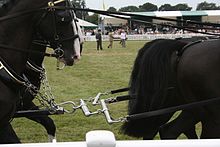equipage
The term equipage describes the equipment and presentation of a team ( carriage ) as a whole.
In addition to the type of car used and its equipment, this also includes the clothing ( livery ) of the driver and servants, as well as the number, tension , equipment and breed of the horses . The equipage indicates the status of its owner. Even small details on the equipage can be important. For example, the execution of the hold-up shows whether the team is being driven by a coachman or the master himself. Shiny, clinking metal stops indicate optically and acoustically that the gentleman is driving himself, while leather stops indicate a normal coachman.
Driving
In driving , different equipages are used in dressage driving, obstacle driving (also called cone driving ), cross-country driving (marathon) and traditional team driving. Open, 4-wheeled, historical, light self-propelled carriages made of wood that look classy and stylish, like buggy or spider, are often used for dressage . For cone and marathon driving, on the other hand, robust marathon cars made of metal with optimal suspension, steering delay and good disc brakes are used, which are well on track and have the lowest possible center of gravity. In traditional driving, carriages are also used, which are typically driven by coachmen.
Hunting riding
The term "equipage" is also used in riding hunts . Here he describes the hunt accompaniment, i.e. the pack and field pickers and the wind instruments.
